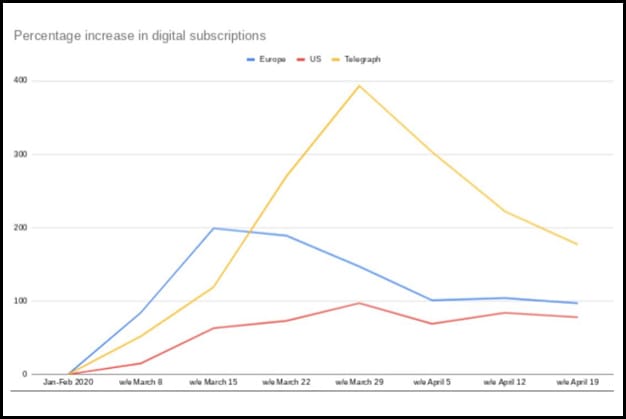2020 challenge: retain new subscribers in a post-pandemic world
The news agenda is rapidly changing. Coronanews fatigue is real. How can publishers turn their 'coronabump' subscribers into loyal readers?



The news agenda is rapidly changing. Coronanews fatigue is real. How can publishers turn their 'coronabump' subscribers into loyal readers?


This article was migrated from an old version of our website in 2025. As a result, it might have some low-quality images or non-functioning links - if there's any issues you'd like to see fixed, get in touch with us at info@journalism.co.uk.
Half of the people in the UK say nothing could persuade them to pay for their news.
This shocking figure comes from the recent Reuters Digital News Report (DNR) 2020. The study also found that, in reality, just seven per cent of UK readers pay for online news.
"From the reader’s perspective, would you pay for news?" asked Robbie Kellman Baxter, strategy consultant, Peninsula Strategies at last month’s Newsrewired conference (29 June 2020).
Baxter is an expert on subscription strategies, having published several books on the topic, most recently "Forever Transaction", a dive into retaining readers and subscribers.
The DNR posits that people’s reluctance to pay for news in the UK could be partly due to the availability of quality news from BBC and open-donation media like The Guardian.
A news organisation makes a "forever promise" to its readers to keep them informed and help them make decisions about the world, Baxter said. But if that promise can be fulfilled elsewhere for free, generally, readers will not stick around.
"You have to solve a different problem, go deeper in another area - maybe it’s more local, business or sport," she says.
"Before you even communicate the value [of news], you want to make sure that from reader’s perspective, you actually have a differentiated value that is solving a different problem."
The coronavirus pandemic has resulted in increased subscriptions to news products, making it a rare opportunity for some publishers to strengthen their revenue model. But now, many are finding that sudden interest waning.
The Telegraph, for example, saw a 400 per cent increase in digital subscriptions at the peak of the pandemic at the end of March. However, that surge had halved by mid-April.

"How do you onboard new members who come for one feature to stay for the rest?" asks Baxter. "How do you teach them to make your offering a habit and to use that moment when they are all coming to you for one reason, to introduce them to the other benefits of being part of a subscription?
"If you introduce them to those other features and help them establish habits that are more ongoing, they are less likely to leave.
"So for news organisations right now, if I were in your shoes, I would be thinking about how to expand the relationship beyond the covid-19 content, how to make it as easy as possible for readers to customise the experience and make it as comfortable and unique as possible."
The Telegraph’s plan from the beginning was exactly this; to emphasise early engagement and show the new subscribers their membership has value beyond the pandemic.
From offering its readers phone calls with sports columnists to launching new editorial products like newsletters, podcasts, Snapchat series and Facebook Groups, The Telegraph created an initial stimulus.
"We’ve concentrated on those who are likely to stay, and separate that from the big anonymous audience who have been coming to the website over the last few months," said Beth Ashton, head of audience and subscriptions, The Telegraph, speaking at Newsrewired on the same day.
Baxter reminded us that spikes are normal for news organisations when crises hit. Understanding in detail the difference between those who stay after the crisis, compared to those who will leave, will help you determine who to focus on and what behaviours to encourage in future crises.
"Then you can make you own decisions as to whether people who aren’t going to convert into regular readers should still have access to free content because it’s the right thing to do, or whether you want to charge because you know they are only staying for a finite duration."
Among all the shiny new features you can tempt new subscribers with, you have to focus on what originally attracted them.
"Give them what they came for," says Baxter. "If I’m subscribing, it’s probably because there’s an article that I bumped up against a paywall for. I really want to read it, so number one: let me do what brought me here in the first place."
"Second: reinforce the wisdom of my decision to subscribe (‘Welcome, you have so much at your disposal, you are supporting credible journalism’). Third: show them what they are entitled to and what other people like them have done to get the most value for what they are already paying for."
By getting your best readers to sample as many products as possible, you can gain priceless insights into how they value your offering. Look for consistencies and patterns and offer your subsequent subscribers what works best to decrease the odds of churn.
"The strategy is really about helping them make the habits which are going to justify the subscription price."
No matter how good your subscription programmes are, the fact remains some people will still cancel. It is how you handle the process that matters.
Much the opposite of making the progess wrought with difficulties, Baxter advised it is best to make the cancellation as easy as possible.
"I always say don’t hide the cancel button," she says. "If you want to prevent cancellation, the moment of cancellation is really too late to do that. You can certainly win some people back or offer them a lower price, or make it so hard to cancel it ends up extending their lifetime by one or two months.
"In the long-term, both of those tactics actually hurt your brand equity and hurt your relationship with that individual subscriber."
Easy to leave means easy to return, she explained, and Netflix is the best example of that. The platform only offers monthly subscriptions to make sure it always remains relevant and also cancels ‘zombie revenue’ - accounts left unused for more than a year.
"That just gives further evidence about how strongly they feel about not getting revenue from people who don’t want to be there or don’t get value from it."